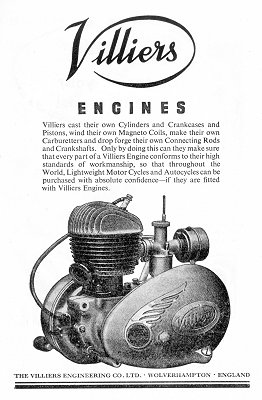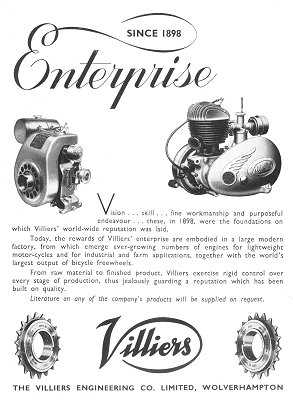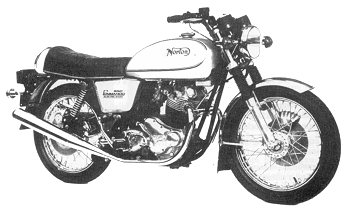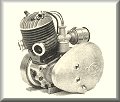The Villiers Engineering Co. Ltd.
1946 onwards
|
After the war demand continued to be very strong and the
company was almost constantly expanding and re-organizing. In 1956
Villiers produced its two millionth engine and duly presented it to the
Science Museum. |
| In 1957 they "absorbed" J. A. Prestwich Industries Ltd.,
makers of the J.A.P. engines. In 1962 the company were claiming
that: "jointly the two companies produce a vast range of two-stroke and
four-stroke petrol engines and four-stroke diesel engines from 1/3rd to
16 bhp.
These are the engines which power many of Britain's
two-stroke motor cycles, scooters and three wheelers and the great
majority of the motor mowers, cultivators, concrete mixers, generating
sets, elevators, pumping sets. etc."
Not only that but the
old standbys continued: "in fifty-eight years [Villiers] have sent
nearly seventy millions [bicycle free wheels] to all parts of the
world".
Not only did the company produce engines but, as they said in
1962: "The Villiers Group offers an extensive service to industry in the
supply of drop forgings, castings, pressings and metal fabrications,
spur, bevel and helical gears, and in the design and manufacture of
Viltool special-purpose machine tools, using the Viltool unit heads and
the 'building block' system of tooling." |

This 1951 Excelsior was fitted with a Villiers
197cc two stroke engine. |

An advert from 1956.

An advert from 1951. |
Overseas the company had subsidiaries in
Australia (Ballarat), New Zealand and Germany and associate companies in
Spain and India.
To give an impression of how widely used Villiers
engines were here is a list, names only, of motorbikes which had
Villiers engines in some or all of their models in the post World
War II period alone: Aberdale, ABJ, AJS, AJW, Ambassador, BAC,
Bond, Bown, Butler, Commander, Corgi, Cotton, Cyc-Auto, DMW, Dot,
Excelsior, Francis-Burnett, Greeves, HJH, James, Mercury, New
Hudson, Norman, OEC, Panther, Radco, Rainbow, Scorpion, Sprite, Sun,
Tandon.
In the early 1960's the company was taken over by
Manganese Bronze Holdings, who also purchased Associated Motor Cycles (A.M.C.)
in 1966.
A.M.C. was formed in 1931 when A.J.S. was purchased by
Matchless. In 1952 A.M.C. acquired Norton Motors Limited who produced
Norton motorcycles. |
|
After A.M.C.'s collapse and take-over in 1966, a
new company called Norton Villiers was formed, which would produce
machines using the Norton name. A new flagship machine was needed to
replace the current ageing models, and so in 1967 the Commando was
developed, just in time for the Earls Court Show.
The first production
machines were completed in April 1968, but there were bending problems
with the frame and so a new frame was developed, and introduced in
January 1969. The original model, now called the 'Fastback' was joined
by the 'S Type' which had a high level left-side exhaust and a 2.5
gallon petrol tank.
Initially
the engines were produced in Wolverhampton, the frames in Manchester and
the components were assembled at Burrage Grove, Plumstead. The Plumstead
works were subject to a Greater London Council compulsory purchase
order, late in 1968 and closed in the following July. |

An advert from 1953. |
|
After a Government subsidy, an assembly line
was set up in a factory at North Way, Andover, with the Test
Department in an aircraft hanger on nearby Thruxton Airfield.
Manufacturing also took place in Wolverhampton,
where about 80 complete machines were produced each week. Components
and complete engines and gearboxes were also shipped overnight, from
Wolverhampton to the Andover assembly line.
The police were showing a lot of interest in
the Commando and so Neale Shilton was recruited from Triumph to
produce a Commando to police specifications. The end result was the
'Interpol' machine, which sold in good numbers to police forces,
both at home and abroad. The machine was powered by a 750 c.c. O.H.V.
engine and included panniers, top box, fairing, and had fittings for
a radio and auxiliary equipment.
Right
from the beginning the Commando took part in racing events, and
after its win in the 1969 Hutchinson 100 and a second place in the
Production T.T., the company decided to produce a racing model. This
led to the development of the successful 750 c.c. overhead valve
'Production Racer'. It featured a tuned engine, front disk brake and
was finished in bright yellow, which led to the machine being known
as the 'Yellow Peril'. |

The Norton Interstate. Courtesy of the late Jim Boulton. |
A new version of the 'S Type' was introduced in
March 1970, called the 'Roadster'. It had a 750 c.c. O.H.V. engine and a
low-level exhaust, with upward angled silencers and reverse cones. The
model 'S' was discontinued in June.
September
1970 saw the introduction of the 'Fastback MK. 2', which was soon
replaced by the Mk.3. It had alloy levers and modified stands and chain
guards. |
|
The ‘Street Scrambler’ and the ‘Hi Rider’ were
launched in May 1971 and the ‘Fastback Long Range’ with a larger petrol
tank, was launched in July. January 1972 saw the appearance of the ‘Mk.4
Fastback’, an updated ‘Roadster’ and the ‘750 Interstate’, with its high
performance ‘Combat’ engine. The ‘Combat’ could deliver 65 b.h.p. at
6500 r.p.m. with a 10 to 1 compression ratio. Unfortunately the engine
proved to be extremely unreliable, main bearing failures were common and
pistons tended to break off at a slot, under the oil control ring. These
problems gave the company a bad reputation, which wasn’t helped by the
fact that the ‘Commando’ suffered from quality control problems which
were well covered in the motorcycling press.
By the middle of 1972 the BSA-Triumph group were in
serious financial trouble and the Government decided to bail the company
out with a financial rescue package, providing it would agree to merge
with Norton Villiers. This led to the formation of Norton Villiers
Triumph Manufacturing Limited, but the new company got off to a shaky
start.
In January
1973 the ‘Mk.5 Fastback’ was launched and the ‘Long Range’ discontinued.
In April the ‘Roadster’, ‘Hi Rider’ and the ‘Interstate’ all began to
use a new 828 c.c. engine. Development work also began on a 500 c.c.
twin, stepped piston engine, with a monocoque pressed steel frame. The
new engine, called the ‘Wulf’, was dropped in favour of developing the
rotary Wankel type engine that had been inherited from BSA. |
|
Things
went well that year for the Norton racing team. Peter Williams won the
1973 Formula 750 T.T. and Mick Grant came in second. Unfortunately the
company itself was in deep financial trouble and redundancy notices were
issued at Andover, which was followed by a sit-in at the works.
The
situation continued to deteriorate in 1974 and came to a head in June
when the Government withdrew its subsidy. |

The 750 Commando. Courtesy of the late Jim Boulton. |
|
There was a general election and luckily the
incoming Labour Government restored the subsidy. The company decided to
close two of its sites and concentrate production at Wolverhampton and
Small Heath. This caused a lot of industrial unrest at Meriden, and
resulted in a workers’ sit in, which stopped production at Small Heath.
By the end of the year the company had lost over 3 million pounds.
Even during these hard times the company still
managed to produce new models. 1974 saw the release of the ‘828
Roadster’, the ‘Mk.2 Hi Rider’, the ‘JPN Replica’ and the ‘Mk.2a
Interstate’. Only two of these were to continue in production the
following year. Early in 1975 the company reduced its range of models to
just two machines, the ‘Mk.3 Interstate’ and the ‘Roadster’. Both
machines were improved by the fitting of an electric starter, a left
side gear change, right foot brake and rear disk brake.
Things went from bad to worse in July when the
Industry Minister recalled a loan for 4 million pounds and refused to
renew the company’s export credits. The company then went into
receivership and redundancies were announced for all of the staff at the
various sites. At Wolverhampton an action committee was formed in an
effort to continue production and develop the ‘Wulf’ engine. The works
were picketed and a prototype machine called the ‘Norton 76’ was
produced. This came to nothing as the Wolverhampton works never
reopened. It was a sad end to such an important company, and a bitter
one. Many of the local workers never received the money that was owed to
them.
Norton
Villiers Triumph managed to survive when the Government stepped in to
save part of the company, but unfortunately this did not include the
Wolverhampton factory. The British motor cycle industry was in its death
throes. The market for British machines disappeared, there was not
enough demand to maintain the factory. With a strange burst of
enthusiasm the company bought the gates from the now demolished Tong
Castle and erected them at the works entrance in Marston Road. It was a
last gesture. |
 |
|
 |
|
 |
| Return to World
War Two |
|
Return to the
Beginning |
|
Proceed to
Motorcycle Engines |
|